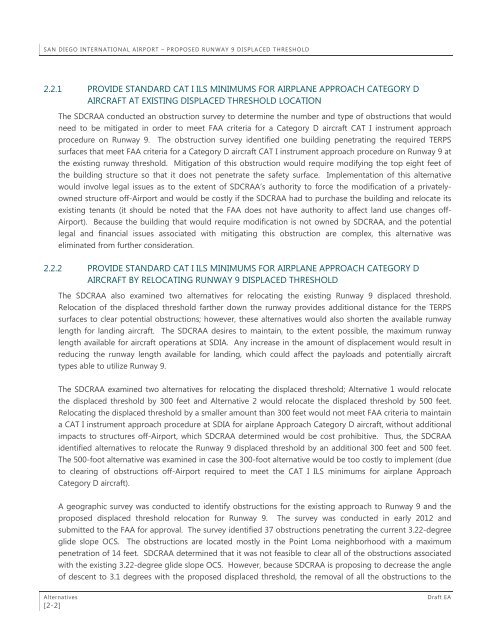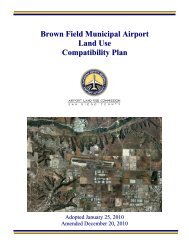Draft EA - San Diego International Airport
Draft EA - San Diego International Airport
Draft EA - San Diego International Airport
You also want an ePaper? Increase the reach of your titles
YUMPU automatically turns print PDFs into web optimized ePapers that Google loves.
SAN DIEGO INTERNATIONAL AIRPORT – PROPOSED RUNWAY 9 DISPLACED THRESHOLD<br />
2.2.1 PROVIDE STANDARD CAT I ILS MINIMUMS FOR AIRPLANE APPROACH CATEGORY D<br />
AIRCRAFT AT EXISTING DISPLACED THRESHOLD LOCATION<br />
The SDCRAA conducted an obstruction survey to determine the number and type of obstructions that would<br />
need to be mitigated in order to meet FAA criteria for a Category D aircraft CAT I instrument approach<br />
procedure on Runway 9. The obstruction survey identified one building penetrating the required TERPS<br />
surfaces that meet FAA criteria for a Category D aircraft CAT I instrument approach procedure on Runway 9 at<br />
the existing runway threshold. Mitigation of this obstruction would require modifying the top eight feet of<br />
the building structure so that it does not penetrate the safety surface. Implementation of this alternative<br />
would involve legal issues as to the extent of SDCRAA’s authority to force the modification of a privatelyowned<br />
structure off-<strong>Airport</strong> and would be costly if the SDCRAA had to purchase the building and relocate its<br />
existing tenants (it should be noted that the FAA does not have authority to affect land use changes off-<br />
<strong>Airport</strong>). Because the building that would require modification is not owned by SDCRAA, and the potential<br />
legal and financial issues associated with mitigating this obstruction are complex, this alternative was<br />
eliminated from further consideration.<br />
2.2.2 PROVIDE STANDARD CAT I ILS MINIMUMS FOR AIRPLANE APPROACH CATEGORY D<br />
AIRCRAFT BY RELOCATING RUNWAY 9 DISPLACED THRESHOLD<br />
The SDCRAA also examined two alternatives for relocating the existing Runway 9 displaced threshold.<br />
Relocation of the displaced threshold farther down the runway provides additional distance for the TERPS<br />
surfaces to clear potential obstructions; however, these alternatives would also shorten the available runway<br />
length for landing aircraft. The SDCRAA desires to maintain, to the extent possible, the maximum runway<br />
length available for aircraft operations at SDIA. Any increase in the amount of displacement would result in<br />
reducing the runway length available for landing, which could affect the payloads and potentially aircraft<br />
types able to utilize Runway 9.<br />
The SDCRAA examined two alternatives for relocating the displaced threshold; Alternative 1 would relocate<br />
the displaced threshold by 300 feet and Alternative 2 would relocate the displaced threshold by 500 feet.<br />
Relocating the displaced threshold by a smaller amount than 300 feet would not meet FAA criteria to maintain<br />
a CAT I instrument approach procedure at SDIA for airplane Approach Category D aircraft, without additional<br />
impacts to structures off-<strong>Airport</strong>, which SDCRAA determined would be cost prohibitive. Thus, the SDCRAA<br />
identified alternatives to relocate the Runway 9 displaced threshold by an additional 300 feet and 500 feet.<br />
The 500-foot alternative was examined in case the 300-foot alternative would be too costly to implement (due<br />
to clearing of obstructions off-<strong>Airport</strong> required to meet the CAT I ILS minimums for airplane Approach<br />
Category D aircraft).<br />
A geographic survey was conducted to identify obstructions for the existing approach to Runway 9 and the<br />
proposed displaced threshold relocation for Runway 9. The survey was conducted in early 2012 and<br />
submitted to the FAA for approval. The survey identified 37 obstructions penetrating the current 3.22-degree<br />
glide slope OCS. The obstructions are located mostly in the Point Loma neighborhood with a maximum<br />
penetration of 14 feet. SDCRAA determined that it was not feasible to clear all of the obstructions associated<br />
with the existing 3.22-degree glide slope OCS. However, because SDCRAA is proposing to decrease the angle<br />
of descent to 3.1 degrees with the proposed displaced threshold, the removal of all the obstructions to the<br />
Alternatives<br />
[2-2]<br />
<strong>Draft</strong> <strong>EA</strong>
















